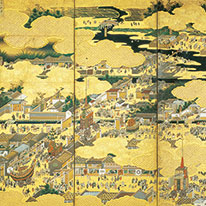Past Exhibitions
- Feature Exhibition: Olympia Meets Japanese Art
- June 5, 2021 - July 4, 2021
The Kyoto National Museum is pleased to present treasures from its collection to compare and contrast the ancient Olympics in Greece and religious folkways in Japan. The people of ancient Greece worshipped many gods and goddesses, and among the famous Panhellenic Games held to honor their deities, the most important and famous were the games held every four years at Olympia. Sacred ground to all Greeks, Olympia was a center of religious worship and the location of a magnificent temple to Zeus, lord of the heavens and almighty in the Greek pantheon. The athletes who competed at Olympia trained their minds and bodies to compete before these gods. The victors were feasted for days on end and gained the right to dedicate a statue of themselves on the temple grounds. In their home communities they were honored for the rest of their lives.
Like the ancient Greeks, Japanese since distant antiquity worshipped many deities, competed with each other in the presence of the divine, trained themselves mind and body, celebrated their victories, and feasted together with their gods.
This exhibit introduces art of Japan and East Asia that resonates with the stories and legends of the ancient Olympics, creating what we hope will be an opportunity to enjoy the arts of Asia while learning more about the world of ancient Greece.
7. From Day One of the Ancient Olympics
The ancient Olympics were held for five days. The first day began with a parade, and after a contest among the trumpeters, each athlete would sacrifice an animal at the altar of Zeus and consult the oracle. They devoted the rest of the day to strolling in the sacred woods of the mountain, enjoying the prized collection of art in the treasure hall, and listening to the poets, philosophers, and historians who had gathered for the occasion.
On the second day, the games began in earnest. Foot races, horse racing, longjump, disc throwing, javelin throwing, wrestling, and chariot racing were among the events. For the chariot races, the glory went to the owner of the chariot rather than its driver, and though women were barred from competing in the games, it was by this means that a wealthy female sponsor of a chariot did receive a winning wreath.
On the third day, which was timed to coincide with the full moon, the most important religious ceremony was held. Led by the high priest of the temple, the competitors, their trainers, and the judges formed a procession to the Temple where some 100 oxen would be sacrificed to Zeus. After that were events for young men—short-distance races, wrestling, and boxing—but it is said the age limits were difficult to judge and some rather mature bodies were often found among the youths. The meat from oxen that had been sacrificed was shared among all gathered, spectators included, in a great feast held in the evening.












